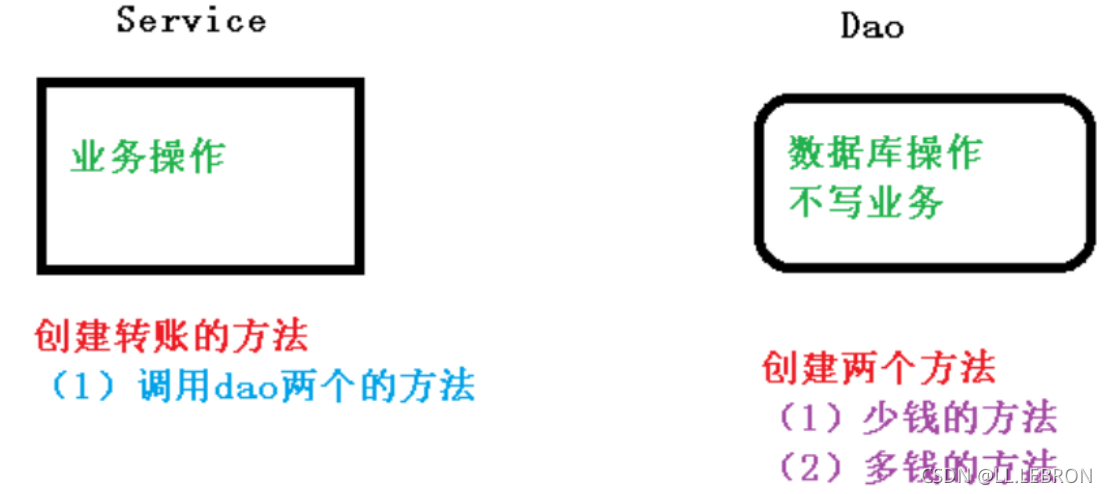文章目录
Spring中事务的使用与配置
1.事务概念
什么是事务?
①事务是数据库操作最基本单元,逻辑上一组操作,要么都成功,如果有一个失败所有操作都失败
②典型场景:银行转账 ,张三转账 100 元给李四, 张三少 100,李四多 100事务的四个特性(ACID):
①原子性
②一致性
③隔离性
④持久性
2.事务操作(模拟事务操作环境)

①创建 service,搭建 dao,完成对象创建和注入关系
//(1)service 注入 dao,在 dao 注入 JdbcTemplate,在 JdbcTemplate 注入 DataSource@ServicepublicclassUserService{//注入 dao@AutowiredprivateUserDao userDao;}@RepositorypublicclassUserDaoImplimplementsUserDao{@AutowiredprivateJdbcTemplate jdbcTemplate;}②在 dao 创建两个方法:多钱和少钱的方法,在 service 创建方法(转账的方法)
@RepositorypublicclassUserDaoImplimplementsUserDao{@AutowiredprivateJdbcTemplate jdbcTemplate;//lucy 转账 100 给 mary//少钱@OverridepublicvoidreduceMoney(){String sql="update t_account set money=money-? where username=?";
jdbcTemplate.update(sql,100,"lucy");}//多钱@OverridepublicvoidaddMoney(){String sql="update t_account set money=money+? where username=?";
jdbcTemplate.update(sql,100,"mary");}}@ServicepublicclassUserService{//注入 dao@AutowiredprivateUserDao userDao;//转账的方法publicvoidaccountMoney(){//lucy 少 100
userDao.reduceMoney();//mary 多 100
userDao.addMoney();}}/**
上边代码正常执行没有问题,
但是如果代码执行过程中出现异常,有问题,如下模拟异常!
*/@ServicepublicclassUserService{//这里执行后将会产生错误(异常),lucy 少 100后,mary不会多 100,这就不对了!!privateUserDao userDao;//转账方法publicvoidaccountMoney(){
userDao.reduceMoney();//lucy 少 100int x=10/0;
userDao.addMoney();//mary 多 100}}//解决上边的异常方法——【编程式事务(传统方法)】//转账的方法publicvoidaccountMoney(){try{//第一步 开启事务//第二步 进行业务操作//lucy少100
userDao.reduceMoney();//模拟异常int i=10/0;//mary多100
userDao.addMoney();//第三步 没有发生异常,提交事务}catch(Exception e){//第四步 出现异常,事务回滚}}3.事务管理(Spring事务管理)
事务添加到 JavaEE 三层结构里面Service 层(业务逻辑层)
在 Spring 进行事务管理操作 ;两种方式:
①编程式事务管理、
②声明式事务管理(推荐使用)
声明式事务管理 :
①基于注解方式(推荐使用)
②基于 xml 配置文件方式
在 Spring 进行声明式事务管理,底层使用 AOP 原理
Spring 事务管理 API :提供一个接口,代表事务管理器,这个接口针对不同的框架提供不同的实现类
4.事务操作(注解声明式事务管理)
在 spring 配置文件,配置事务管理器
<!--创建事务管理器--><beanid="transactionManager"class="org.springframework.jdbc.datasource.DataSourceTransactionManager"><!--注入数据源--><propertyname="dataSource"ref="dataSource"></property></bean>在 spring 配置文件,开启事务注解
<!--开启事务注解--><tx:annotation-driventransactionmanager="transactionManager"></tx:annotation-driven>在 service 类上面(或者 service 类里面方法上面)添加事务注解
①@Transactional,这个注解添加到类上面,也可以添加方法上面
②如果把这个注解添加类上面,这个类里面所有的方法都添加事务
③如果把这个注解添加方法上面,为这个方法添加事务
@Service@TransactionalpublicclassUserService{@AutowiredprivateUserDao userDao;publicvoidaccountMony(){ userDao.reduceMoney();int i=10/0; userDao.addMoney();}}
5.事务操作(声明式事务管理参数配置)
propagation(事务传播行为):多事务方法直接进行调用,这个过程中事务是如何进行管理的。

spring框架事务传播行为有七种:下面只介绍常用的两种传播行为
①REQUIRED:如果add方法本身有事务,调用update方法后,update使用当前add方法里面的事务。 如果add方法本身没有事务,调用update方法后,创建新的事务。
②REQUIRED_NEW:使用add调用update方法,不论add方法是否有事务,都会创建新的事务。
@Transactional(propagation=Propagation.REQUIRED,)//事务一publicvoidadd(){//调用update方法update();}publicvoidupdate(){//事务二}Spring定义的7种类传播行为:
![a\Roaming\Typora\typora-user-images\image-20210831150628695.png)]](http://img.555519.xyz/uploads/20230912/4bb239889d1f30fbf12ee3e1c81612ff.jpg)
ioslation(事务隔离级别)
事务有特性成为隔离性,多事务操作之间不会产生影响。不考虑隔离性产生很多问题 。有三个读问题:脏读、不可重复读、虚(幻)读 。
①脏读:一个未提交事务读取到另一个未提交事务的数据。
②不可重复读:一个未提交事务读取到另一提交事务修改数据。
③虚读:一个未提交事务读取到另一提交事务添加数据。
解决办法:通过设置事务隔离级别,解决读问题
脏读 不可重复读 幻读 READ UNCOMMITTED(读未提交) 有 有 有 READ COMMITTED(读已提交) 无 有 有 REPEATABLE READ(可重复读) 无 无 有 SERIALIZABLE(串行化) 无 无 无 @Transactional(propagation=Propagation.REQUIRED,isolation=Isolation.REPEATABLE_READ)timeout(超时时间)
①事务需要在一定时间内进行提交,如果不提交进行回滚 。
②默认值是 -1(不超时) ,设置时间以秒单位进行计算。
readOnly(是否只读)
①读:查询操作,写:添加修改删除操作。
②readOnly 默认值 false,表示可以查询,可以添加修改删除操作。
③设置 readOnly 值是 true,设置成 true 之后,只能查询。
rollbackFor(回滚)
设置出现哪些异常进行事务回滚
noRollbackFor(不回滚)
设置出现哪些异常不进行事务回滚
6.事务操作(XML 声明式事务管理)
在 spring 配置文件中进行配置 :
①配置事务管理器
②配置通知
③配置切入点和切面
<!--1 创建事务管理器--><beanid="transactionManager"class="org.springframework.jdbc.datasource.DataSourceTransactionManager"><!--注入数据源--><propertyname="dataSource"ref="dataSource"></property></bean><!--2 配置通知--><tx:adviceid="txadvice"><!--配置事务参数--><tx:attributes><!--指定哪种规则的方法上面添加事务--><tx:methodname="accountMoney"propagation="REQUIRED"/><!--<tx:method name="account*"/>--></tx:attributes></tx:advice><!--3 配置切入点和切面--><aop:config><!--配置切入点--><aop:pointcutid="pt"expression="execution(* com.atguigu.spring5.service.UserService.*(..))"/><!--配置切面--><aop:advisoradvice-ref="txadvice"pointcut-ref="pt"/></aop:config>
7.事务操作(完全注解声明式事务管理)
创建配置类,使用配置类替代 xml 配置文件
//1、创建配置类,使用配置类替代 xml 配置文件@Configuration//配置类@ComponentScan(basePackages="com.atguigu")//组件扫描@EnableTransactionManagement//开启事务publicclassTxConfig{//创建数据库连接池@BeanpublicDruidDataSourcegetDruidDataSource(){DruidDataSource dataSource=newDruidDataSource();
dataSource.setDriverClassName("com.mysql.jdbc.Driver");
dataSource.setUrl("jdbc:mysql:///test");
dataSource.setUsername("root");
dataSource.setPassword("root");return dataSource;}//创建 JdbcTemplate 对象@BeanpublicJdbcTemplategetJdbcTemplate(DataSource dataSource){//从IOC容器中拿到配置注入的数据源//到 ioc 容器中根据类型找到 dataSourceJdbcTemplate jdbcTemplate=newJdbcTemplate();//注入 dataSource
jdbcTemplate.setDataSource(dataSource);return jdbcTemplate;}//创建事务管理器@BeanpublicDataSourceTransactionManagergetDataSourceTransactionManager(DataSource dataSource){DataSourceTransactionManager transactionManager=newDataSourceTransactionManager();
transactionManager.setDataSource(dataSource);return transactionManager;}}@Testpublicvoidtest1(){ApplicationContext context=newAnnotationConfigApplicationContext(TxConfig.class);UserService userService= context.getBean("userService",UserService.class);
userService.accountMony();}